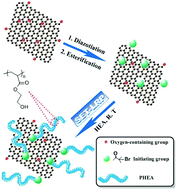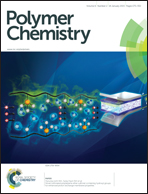Preparation of graphene/poly(2-hydroxyethyl acrylate) nanohybrid materials via an ambient temperature “grafting-from” strategy
Abstract
Graphene has emerged to be a promising material due to its unique structure and two-dimensional and extensively conjugated surface. However, graphene tends to aggregate in an almost irreversible manner, it is therefore useful to modify carbon sheets to achieve solubility for further applications. Herein, we report a new graphene/polymer nanohybrid material, graphene/poly(2-hydroxyethyl acrylate) (G-PHEA), aiming to improve its solubility in regular solvents. The preparation of PHEA polymer brushes on the surfaces of reduced graphene oxide sheets was accomplished by in situ single-electron transfer living radical polymerization (SET-LRP) under mild conditions via the “grafting-from” strategy. Initiating groups containing graphene sheets were prepared by a diazonium reaction followed by esterification for attaching Br-containing initiating groups onto the surface of graphene. Surface-initiated SET-LRP of 2-hydroxylethyl acrylate was performed in DMSO in the presence of a Cu wire/Me6TREN catalytic system at room temperature to form G-PHEA nanohybrid material. FT-IR, XRD, Raman, TGA, AFM, and TEM measurements showed the efficient PHEA-functionalized covalent modification of graphene with good dispersibility in organic solvents and aqueous media. This kind of nanohybrid material is not cytotoxic by itself and could quickly enter into SMMC-7721 and SH-SY5Y cells.


 Please wait while we load your content...
Please wait while we load your content...